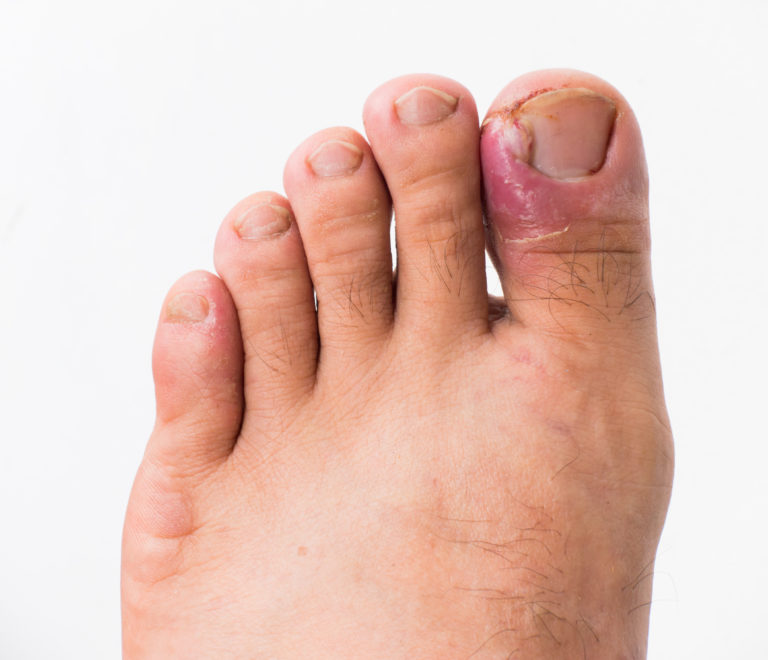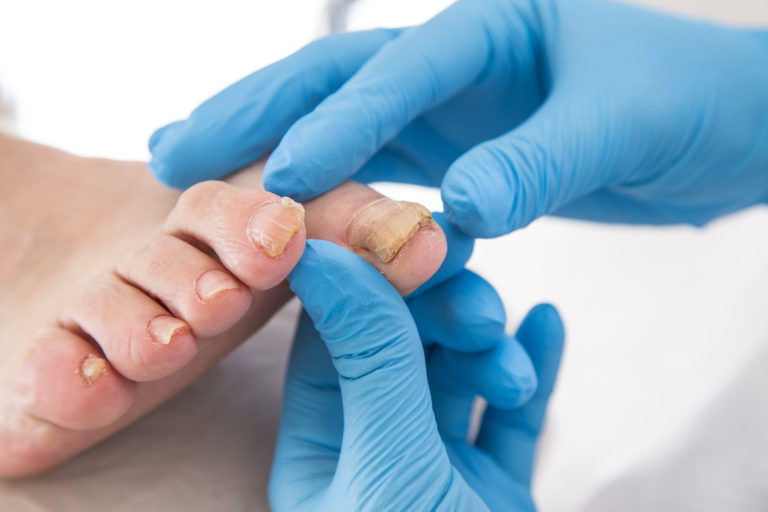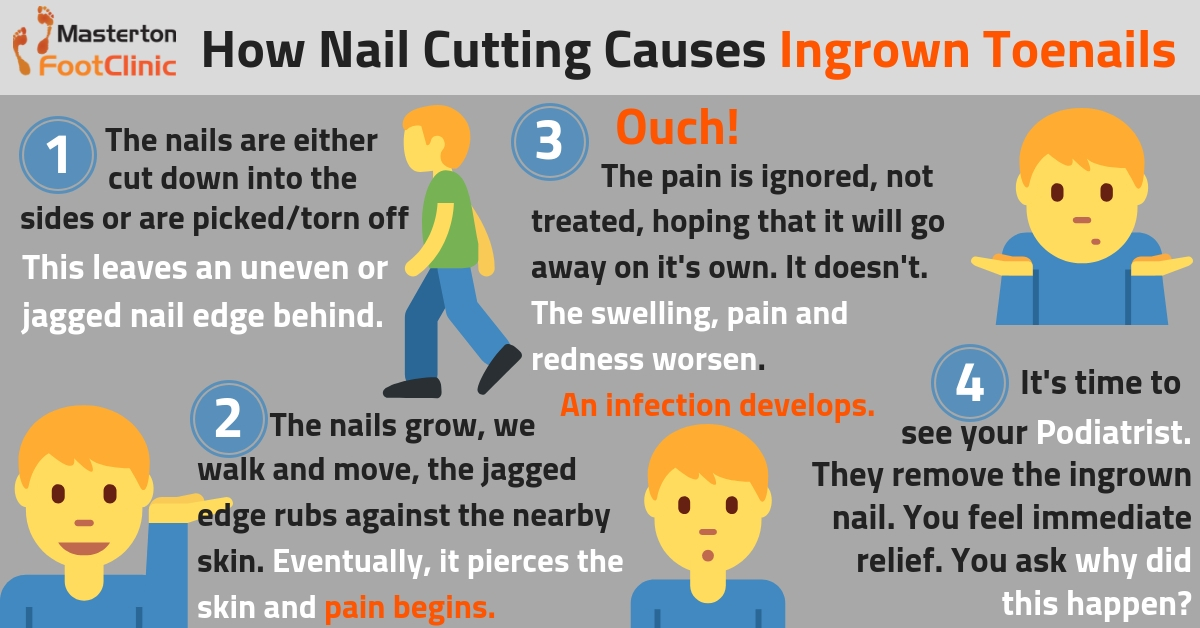 Ingrown toenails are frustrating, painful, and can make performing the simplest daily tasks very difficult. They also tend to get worse and more difficult to fix when left untreated, which means that it’s important to seek treatment immediately.
Ingrown toenails are frustrating, painful, and can make performing the simplest daily tasks very difficult. They also tend to get worse and more difficult to fix when left untreated, which means that it’s important to seek treatment immediately.
What are ingrown toenails?
Having an ingrown toenail means that part of your toenail has pierced and grown into the surrounding skin. Even the smallest piece of nail has the potential to cause severe pain and swelling. This is because while the nail continues to pierce the skin, the cut it has created in the skin cannot close and heal. When combined with the slight movement and vibrations through the nail with every step we take, leads to continuing pain, swelling and a lot of ‘ouch!‘ moments throughout the day and night.
Here are some quick facts about ingrown toenails:
- Any nail can become ingrown, though it commonly occurs in the big toes
- One or both sides of the toenail can ingrow at the same time
- This problem can run in families because of similar shapes of the nails
- Once you get an ingrown toenail, you’re more likely to get it again
- Ingrown toenails can occur at any age, even in babies just months old!
- Two of the most common causes of ingrown toenails are tight footwear and an improper nail cutting technique, such as cutting down the sides of the nails or pulling/picking off the nail
You may have an ingrown toenail if:
- The skin surrounding the nail is red, swollen or tender
- You feel pain in the toe which is worsened when you touch it
- The toe may bleed or there may be yellow/white/clear discharge
- It’s painful to wear (tight) shoes because of the pressure on your toe
- Even the pressure from bedsheets feels like daggers or causes an ache/throb
Be aware of infection
Because an ingrown toenail is an open wound, it is vulnerable to infection if bacteria get to it – which isn’t too difficult given the location down at the feet. This is why it’s important to effectively treat ingrown toenails, especially if you have diabetes, nerve damage or poor circulation, all of which increase your risk of complications. If you fall into this category, it’s important that you don’t attempt to treat ingrown toenails at home and instead seek the help of their Podiatrist as soon as possible. If you think you have an infection, make an appointment with your Podiatrist immediately.
Treating Ingrown Toenails
 When it comes to treating ingrown toenails, there are two distinct categories of treatment in podiatry: Conservative care and Surgical correction.
When it comes to treating ingrown toenails, there are two distinct categories of treatment in podiatry: Conservative care and Surgical correction.
Conservative Care
Conservative care means that we remove the troublesome nail edge that has penetrated the skin with minimal impact on the nail itself. It’s simple, quick and usually not done under anaesthetic so there may be a little bit of discomfort that is quickly followed by a lot of relief.
While this is a great option to relieve pain for those with first-time ingrown toenails, this does not permanently correct the nail or stop it from coming back again.
Surgical Correction
Surgical correction means that we complete a minor nail surgery to both remove the bothersome nail edge and importantly, apply a chemical that’ll stop that particular edge growing back! If you tend to get worried about the term ‘surgery’, then please don’t. This small procedure is done within an hour at our clinic in your regular podiatry chair and all under local anaesthetic so you don’t feel a thing.
To put you at ease, you can watch a timelapse of the procedure being completed here at Masterton Foot Clinic: (warning: discretion is advised, this is the actual procedure with no censoring)
We cannot recommend this procedure highly enough as the best solution for ingrown toenails. It:
- Permanently corrects ingrown toenails in one procedure
- Is performed simply and safely in-clinic
- Is completed within 60 minutes, which includes preparing and anaesthetising the foot toe as well as dressing the toe after the procedure is complete
- Performed under local anaesthetic so is pain-free
- Does not require you to take any additional time off work/school following the procedure and you can go home immediately
- Does not require you to wear any special boots or braces while the toe heals
- Causes very little post-procedure discomfort, however, painkillers can be taken should discomfort arise
Unsure if a PNA is right for you?
While we can’t give direct quotes without examining your toe, we are happy to provide guidance and pricing guides if you want to send us a photo of your painful toe and toenail. You can email this to adam@mastertonfootclinic.co.nz
Health Insurance
Masterton Foot Clinic is both a Southern Cross Health Insurance provider and a WINZ accredited provider. We offer no-obligation free WINZ quotes, just call to book an appointment and let our receptionist know.
FAQs
Why do I keep getting ingrown toenails?
The most common reasons for recurring ingrown toenails that we see in our clinic is firstly from a person’s nail cutting technique, meaning that they’re trimming their nails down the sides (or not trimming at all but instead picking or pulling at the nails). Another cause is wearing shoes that have a narrow toe box and are constantly pressing on the sides of the toes, which can push the nail into the skin. There are other factors like those we have mentioned on this page, but these are the ones we see most often.
How can I ease the pain from my ingrown toenails at home?
Avoid wearing shoes that put pressure on the ingrown toenail, and try a gentle foot bath in warm water, soapy water, or water with Epsom salts. While the foot bath won’t fix the problem, it can offer you some temporary relief. You can also take non-steroidal anti-inflammatory medications (NSAIDs) as directed.
Does it hurt to have an ingrown toenail treated?
For our PNA procedures that permanently treat ingrown nails, these are done under local anaesthetic, so are not painful. There may be some tenderness from removing ingrown toenails as a one-off conservative care appointment as the nail is already in the skin, so any movement in the area will feel tender. However, we always aim to keep you as comfortable as possible, and our appointments are well tolerated.
How long does it take to remove an ingrown toenail?
This depends on the type of procedure you have and hence the allocated appointment time, but it takes just one appointment, whether that is 30 minutes or 60 minutes. The actual time taken to get the ingrown nail is very short, spanning just minutes, but we often have some preparation work involved too.
Can you treat infected ingrown toenails?
Yes, though your treatment approach may vary depending on the severity of the infection and if you are currently taking antibiotics. Your podiatrist will conduct a comprehensive assessment of your toe and discuss the best way forwards for you.
Can children have ingrown toenail surgery?
Absolutely, children tend to respond very well to ingrown nail surgery which prevents the recurrence of their pain and problem. We have great success rates with children and their healing efficiency is often much better than in older adults.
My toe is sore by the side of the nail, but it’s not red or swollen. Could this be an ingrown toenail?
Yes it can. The redness and swelling occurs when the nail has penetrated the skin and is acting like a little dagger, which stimulates the inflammation and redness. Before it gets to this stage, the nail will likely be pressing painfully against the skin, until it penetrates and starts growing in. This earlier stage can still be very painful and uncomfortable, despite not having some of the telltale signs of ingrown nails.
Do ingrown toenails only occur on the big toes?
No, ingrown nails can develop on any of the toes, and on one or both sides of the toenail. They may also affect multiple toes at once, on one or both feet. The big toes is just the most common site for an ingrown nail, which is why we often refer to the big toes.
Can babies get ingrown toenails?
Yes, we’ve seen ingrown toenails on toddlers and babies as young as six months old. This can be very distressing, as babies at this younger age cannot communicate the problem. If you notice their toe is red or swollen, or it looks like an ingrown toenail, bring them in to see our podiatrists. We also recommend checking that a hair has not wrapped itself around the baby’s toes, as can happen particularly with postpartum hair loss.


